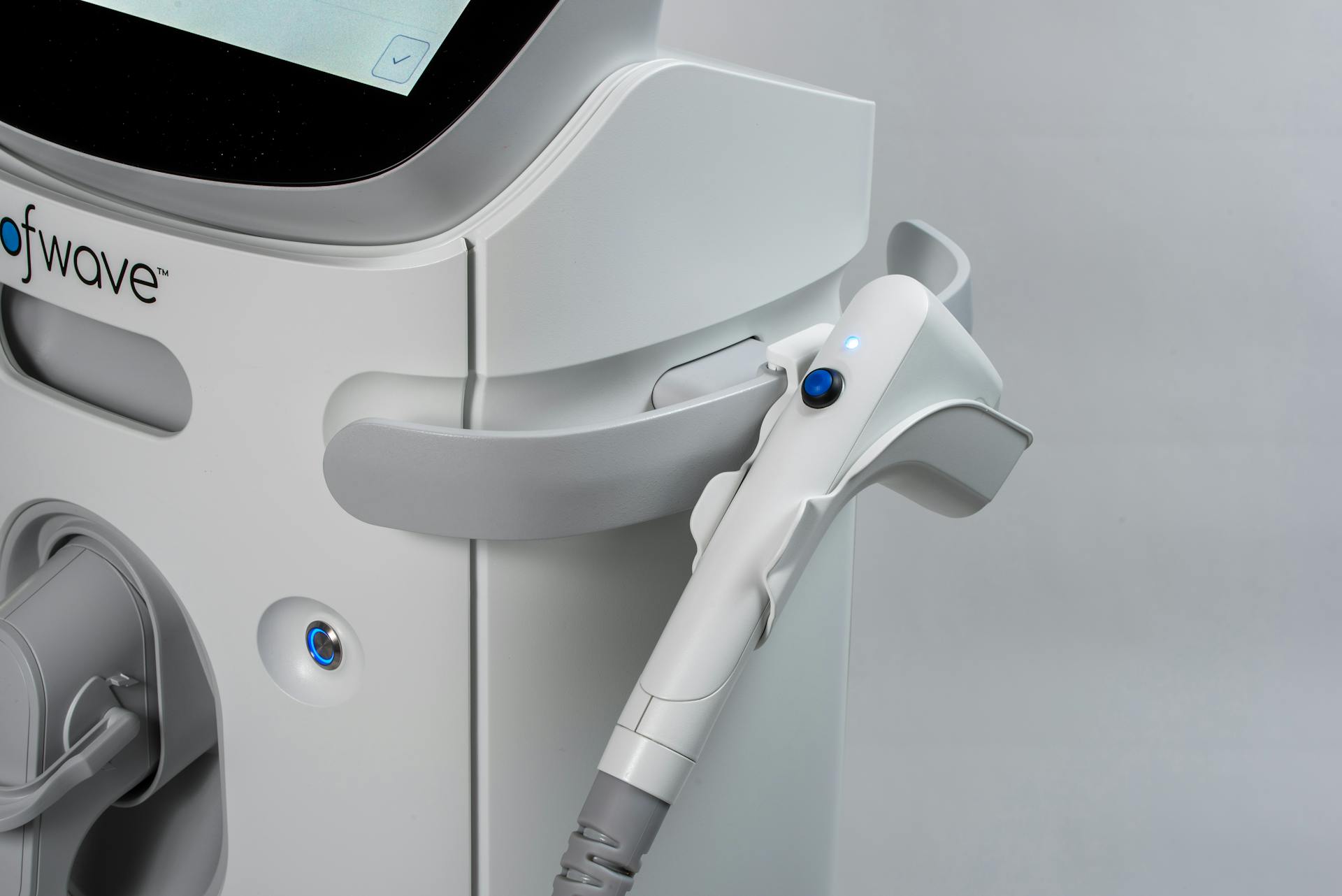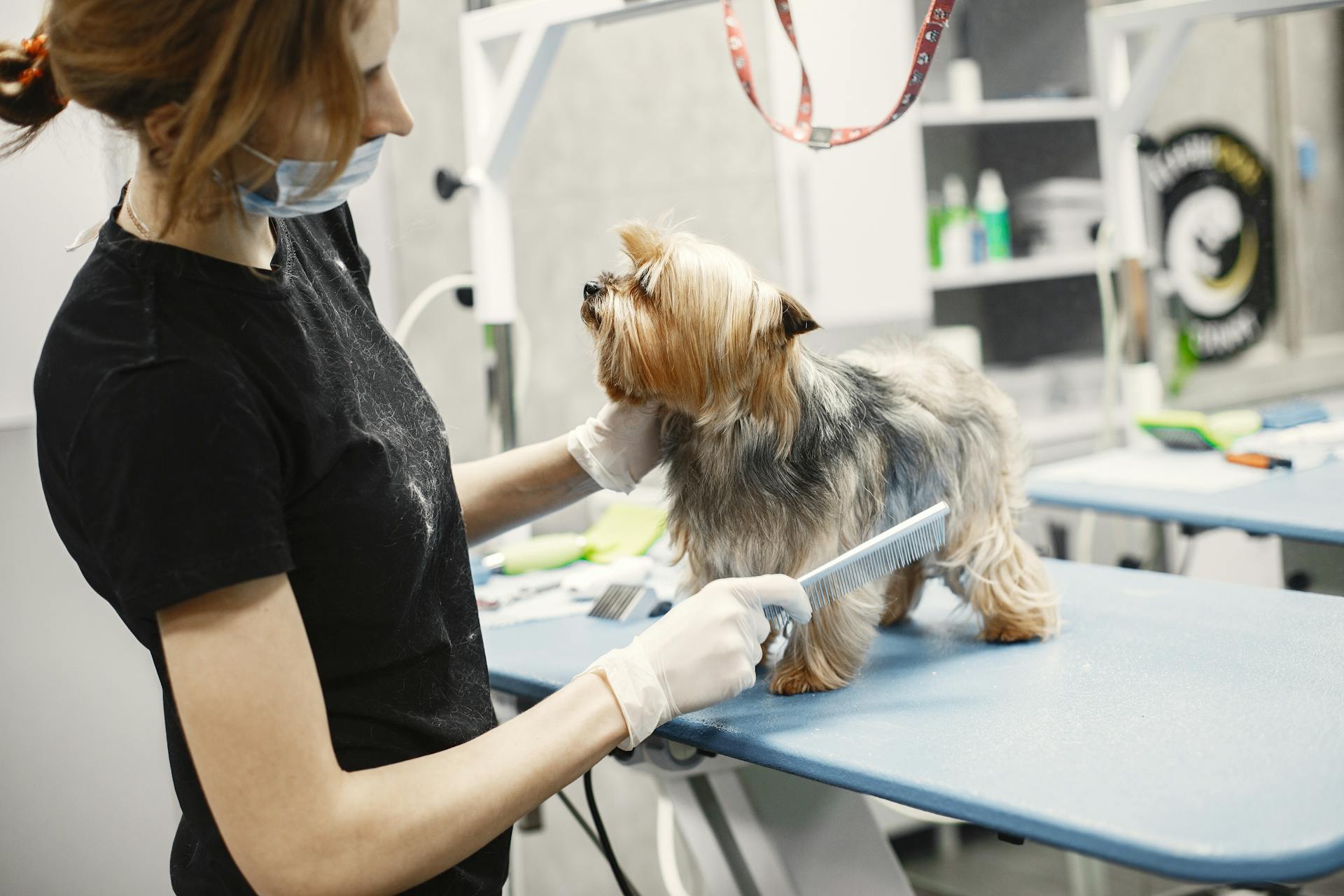
Pyometra is a serious medical condition that affects female dogs and cats, causing a life-threatening infection in the uterus. It's essential to understand the signs, symptoms, and treatment options to ensure prompt and effective care.
In dogs, pyometra often occurs in middle-aged to older females, and the most common breed affected is the Cocker Spaniel. The infection is usually caused by a bacterial buildup in the uterus.
Dogs with pyometra typically exhibit symptoms such as vomiting, diarrhea, and lethargy, but in some cases, they may also show signs of abdominal pain and distension. The infection can also lead to septicemia, a life-threatening condition that affects the entire body.
If left untreated, pyometra can be fatal, but with prompt veterinary care, the prognosis is generally good.
Discover more: Closed Pyometra in Dogs Symptoms
What Is Pyometra?
Pyometra is a serious health issue that affects some female dogs, especially as they age.
It's caused by a buildup of pus in the uterus, which can be life-threatening if left untreated.
In many cases, pyometra is linked to hormonal imbalances, particularly an excess of estrogen.
The condition can be acute or chronic, with acute pyometra being a sudden and severe case that requires immediate veterinary attention.
A dog's age is a significant risk factor, with pyometra most commonly occurring in middle-aged to senior dogs.
In some cases, pyometra can be caused by a uterine infection, which can be triggered by a bacterial or fungal infection.
The symptoms of pyometra can vary, but often include vomiting, diarrhea, lethargy, and abdominal pain.
If you suspect your dog has pyometra, it's essential to seek veterinary care right away, as the condition can quickly become life-threatening.
Causes and Risk Factors
Pyometra is a serious condition that can affect female dogs and cats, and understanding its causes and risk factors is crucial in preventing and treating it.
The risk of developing pyometra differs between dog breeds, and it can happen at any age, whether the dog has bred or not. Pyometra is a result of hormonal and structural changes in the uterus lining, which can occur during a heat cycle.
The main risk period for a female dog is for eight weeks after her peak standing heat has ended, when the cervix begins to close and the inner lining of the uterus starts to adapt back to normal. However, this is also the time when cystic hyperplasia of the endometrium (CEH) may occur, creating a favorable environment for bacteria to grow.
Bacteria, especially E. coli, can migrate from the vagina into the uterus and thrive in the presence of progesterone, which causes mucus secretion, closes the cervix, and decreases uterine contractility.
In cats, pyometra occurs in older intact female cats who have never given birth. This is because the hormonal changes during a heat cycle can lead to thickening of the uterus walls, which can cause cysts to form and release fluid that feeds bacteria.
The cat's cervix also opens to allow sperm to enter, but this also allows bacteria to multiply and grow in the uterus, leading to pyometra.
Worth a look: Symptoms of Pyometra in Cats
Pyometra can be categorized as "open" or "closed", depending on whether the cervix is open or fully closed. If the cervix is open, the infected material can leave the body, but if it's fully closed, the uterus may rupture and pus escapes into the abdomen, causing peritonitis and possible rapid death.
Here are the main causes of pyometra in dogs and cats:
- Dogs: hormonal and structural changes in the uterus lining, cystic hyperplasia of the endometrium (CEH), and bacterial growth.
- Cats: hormonal changes during a heat cycle, thickening of the uterus walls, and cysts forming.
- Spayed cats: stump pyometra, which occurs when an infection happens in the small amount of tissue left behind after a spay.
Clinical Signs and Symptoms
Pyometra can manifest in different ways, depending on whether the cervix is open or closed. If the cervix is open, a discharge of pus from the vulva is a common symptom, often accompanied by a strong odor.
Dogs with open pyometra may or may not exhibit fever, lethargy, anorexia, and depression. In contrast, dogs with closed pyometra become severely ill rapidly, showing symptoms such as anorexia, listlessness, and depression.
A key indicator of closed pyometra is distention of the abdomen, caused by the accumulation of pus in the uterus. This can lead to increased urine production, as the toxins released by the bacteria affect the kidney's ability to retain fluid.
Worth a look: Open Pyometra
Dogs with pyometra may also exhibit vomiting or diarrhea. In both open- and closed-cervix pyometra, dogs drink large amounts of water to compensate for the increased urine production.
Here are some common symptoms of pyometra in dogs:
- Pus draining from the vulva
- Lethargy, depression, or weakness
- Anorexia or decreased appetite
- Increased thirst
- Vomiting or diarrhea
Cats with pyometra can also exhibit a range of symptoms, including pus draining from the vulva, lethargy, depression, or weakness, anorexia or decreased appetite, and increased thirst.
Diagnosis
Diagnosing pyometra can be challenging, especially when it's an open pyometra. Your veterinarian may perform a thorough exam, review your cat's health history, and ask about any unusual behaviors at home, such as excessive drinking or wet spots.
Your vet may also perform tests, including X-rays, blood work, and an ultrasound, which is more sensitive than X-ray and can detect changes in uterine size.
A severe elevation of the white blood cell count is common in dogs with pyometra. They may also have an elevation of globulins, a protein associated with the immune system, in the blood.
How Is Diagnosed?

Diagnosing pyometra in cats and dogs can be a bit tricky, but your veterinarian will use a combination of physical exams, health history, and diagnostic tests to make a proper diagnosis.
Your vet will likely ask about your cat's or dog's heat cycle history and any unusual behaviors, such as excessive drinking or discharge on their bedding. They may also perform a physical exam to check for signs of illness.
Blood work is often part of the diagnostic process, as pyometra can cause a severe elevation of the white blood cell count and an elevation of globulins in the blood.
X-rays may also be used to help diagnose pyometra, although an ultrasound is often more sensitive and can detect changes in uterine size.
In some cases, your vet may perform an ultrasound to get a better look at the uterus and confirm the diagnosis.
Here are some common diagnostic tests used to diagnose pyometra:
- X-rays
- Blood work
- Ultrasound
If your vet suspects pyometra, they may also check for a vaginal discharge or a painful, enlarged abdomen, as these are common signs of the condition.
Diagnosis
A pyometra is a veterinary emergency that requires prompt attention from a veterinarian.
If you suspect your dog has a pyometra, contact your vet for an urgent appointment right away.
A pyometra is an infection of the uterus, and it's a true emergency that can be life-threatening if left untreated.
The only sure way to prevent a pyometra is to spay your dog, which can be done by a veterinarian.
Your dog has the best chance of survival if they receive prompt treatment, so don't hesitate to contact your vet if you notice any symptoms.
Treatment and Management
Surgery is the preferred treatment for pyometra, usually involving an ovariohysterectomy (spay) to remove the uterus and ovaries. This is often the best option for dogs diagnosed early in the disease.
Intravenous fluids are required to stabilize the dog before and after surgery, and antibiotics are usually given for two weeks post-operatively.
Surgical removal of the uterus is also the preferred treatment for pyometra in cats, and typically involves removing both the ovaries and the uterus.
You might enjoy: Pyometra in Dogs Home Remedies
For dogs diagnosed when they are quite ill, surgery can be more complicated and require a longer period of hospitalization.
Prostaglandins can be used to treat pyometra, but their success rate is highly variable and they can cause side effects such as restlessness, panting, and vomiting.
The use of prostaglandins to treat pyometra carries risks, including the possibility of the uterus rupturing and spilling infection into the abdominal cavity, resulting in peritonitis.
In livestock, the treatment of choice for minor cases of pyometra is dinoprost tromethamine (Lutalyse), and supportive antibiotic treatment may also be recommended.
Cats undergoing surgery to treat pyometra often require several days of hospitalization on IV fluids, and their recovery time may vary depending on their overall health.
To prevent infection and promote healing, it's essential to limit your cat's activity for about 2 weeks after surgery, keeping her indoors and avoiding strenuous exercise.
Following surgery, your veterinarian may prescribe oral antibiotics, and you may need to use an E-Collar to prevent your cat from licking or chewing at her incision.
Here's an interesting read: Stump Pyometra Cat
Here's a summary of the typical post-operative care for cats with pyometra:
- Hospitalization on IV fluids for several days
- Limited activity for 2 weeks
- Oral antibiotics as prescribed by your veterinarian
- Use of an E-Collar to prevent licking or chewing at the incision
Your veterinarian will discuss hormone treatment options with you if they are available, but be aware that even if medical treatment is successful, your dog's pyometra may return again after her next season.
Frequently Asked Questions
Can pyometra be cured with antibiotics?
Pyometra typically requires surgical intervention or Prostalgin in addition to antibiotics, as antibiotics alone are unlikely to resolve the condition. Prompt medical treatment is crucial to prevent serious complications, including kidney failure and death.
Sources
- https://vcahospitals.com/know-your-pet/pyometra-in-dogs
- https://en.wikipedia.org/wiki/Pyometra
- https://www.petmd.com/cat/conditions/reproductive/signs-pyometra-cats
- https://vetmed.illinois.edu/pet-health-columns/pyometra-infection-dogs-uterus/
- https://www.pdsa.org.uk/pet-help-and-advice/pet-health-hub/conditions/pyometra-infected-womb-in-dogs
Featured Images: pexels.com


